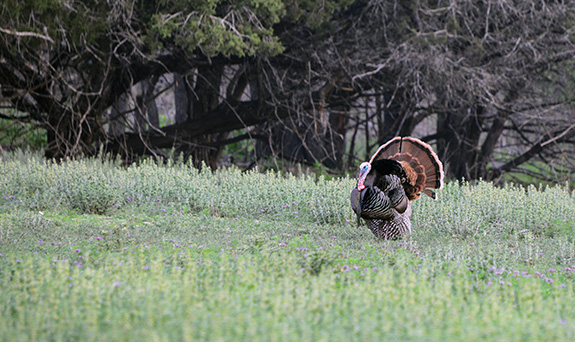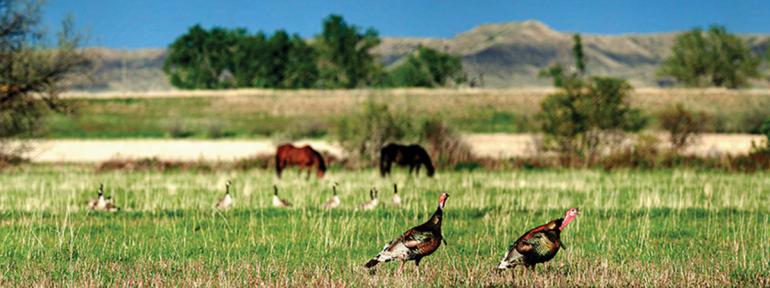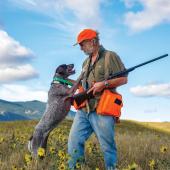Back to the Woods
There's no better motivation than spring turkey season.
When T. S. Eliot declared April the cruelest month, he couldn’t have been living in Montana. As dawn broke that April morning, the sounds of courting snipe and northbound geese filled the sky, and pasqueflowers appeared along the old snow. Somehow, we had all survived another winter.
I hiked a mile of ponderosa pines before I heard what I really came to hear—the haunting gobble of a wild turkey, a sound as surreal as an elk’s bugle. On a calm morning one can carry on for miles, so I hustled to reach the tom before he left his roost and joined his hens. Better an hour early than a minute late.
No matter what the outcome of the encounter ahead, I was already thanking the bird for inviting me back to the woods again.
Real turkey hunting takes place in the spring, when wary males can be called in to close range.
Turkeys formed the main course at the first Thanksgiving dinner (which probably never took place). Ben Franklin wanted them to be our national bird (not quite true either, but it makes another good story.) However, several aspects of wild-turkey lore are undeniably true. It is the largest game bird on the continent. It was widely abundant at the time of European contact. It is incredibly wary and delicious. Its recovery after near decimation a century ago is one of our great wildlife-conservation success stories.
The journals of Lewis and Clark don’t mention wild turkeys as they crossed Montana, though, because there weren’t any. Adapted to milder climates, they couldn’t survive our winters until agriculture provided them feedlots to help them outlast the snow. Now wild turkeys, representing five subspecies, inhabit every state except Alaska. Most Montana birds are Merriam’s turkeys living east of the Continental Divide, although populations of easterns have become established farther west.
Montana offers both spring and fall turkey seasons, with dates and limits varying by region. In the fall, turkeys are largely targets of opportunity for hunters pursuing other game. Real turkey hunting takes place in the spring, when wary males (“toms” or “gobblers”) can be called in to close range. Here’s an introduction to hunting one of our state’s most challenging and exciting quarries.
Finding Turkeys
Turkeys need roost trees. Typical Montana habitat consists of timbered ridges interspersed with meadows, or river bottoms containing cottonwoods. While it’s common to observe turkeys in barnyards and feedlots during winter, they’re likely to be dispersed by the time the season opens in early April. Southeastern Montana is prime turkey country. I killed my first one in the Custer National Forest nearly 50 years ago, and that’s still a good place to start. They are also well established in parts of Region 4 and the Missouri Breaks. Turkey numbers fluctuate considerably from year to year depending on weather during the previous spring, so a discussion with an FWP biologist is wise.
Turkey Behavior
In the spring, turkeys often follow the receding snowline uphill in search of food, and form loose flocks consisting of a dominant gobbler, a dozen or more hens, and a variable number of “satellite” gobblers. They often call vigorously from their roost trees before flying down around first light. Turkeys have poor night vision, so hunters should try to get as close as possible undetected and set up before “fly down.” Hens move toward gobbler calls rather than the other way around. A gobbler’s response to calling can vary from ignoring it to approaching on a run. The more hens near the gobbler, the less likely an immediate response. Be patient, since a gobbler will sometimes return hours later.

Calling
This is the essence of spring turkey hunting, and reams have been written about the subject. My basic advice is twofold: keep it simple and avoid over-calling.
Most turkey calls are meant to imitate hens, including a variety of yelps, purrs, cackles, and cuts. At first, learn the yelp and don’t worry about the rest. Avoid imitating a gobble, which is more likely to call in turkey hunters than turkeys.
Calls come in a variety of forms including box calls (the easiest to master), slates, and mouth diaphragms (which are harder to use but leave the hunter’s hands free). All are effective given the right bird and the right situation. Learn one and stick to it.
Concealment
This is the second key to successful turkey hunting. Turkeys have remarkable vision and are especially adept at detecting movement. If you can’t sit still, you’re not going to call in many turkeys. Gobblers are also good pattern recognizers, so camouflage is important (some of the world’s best is made in Bozeman.) Be sure to conceal your hands and face.
I hunt turkeys with a bow now, so I have to disguise the motion of the draw. I carry lightweight netting in my pack and stretch it across a fallen tree before calling from behind it. This tactic can be valuable for shotgun hunters as well.
Shotguns and Bows
Turkeys are big, tough birds. While I do most of my bird shooting with a 20-gauge, turkeys are an exception. Shoot a full-choke 12-gauge and #2 shot or BBs. Call the bird in close sand aim for the head and neck. Bows can be very effective on turkeys, but don’t underestimate the birds’ toughness. I hunt with the same tackle I use for deer and elk.
I didn’t kill the tom I heard that opening morning. Although he was steadily approaching, a real hen lured him away before he reached bow range. However, he kept me challenged and entertained for hours, and his wariness left me with what I really wanted most from the morning: an excuse to go back out again.
Tungsten Toms: Avoiding toxic shot in the field.
When wildflowers bloom beside dwindling snow patches, many hunters’ thoughts turn toward calling in lovesick gobblers.
Although using lead ammunition to hunt waterfowl was banned in 1991, using lead for upland bird hunting is still considered fair game, despite the health hazards lead poses to children, pregnant women, and avian scavengers like bald and golden eagles.
Sure, those pockets full of steel shotshells that wore holes in your duck-hunting jacket last winter will harvest a gobbler in a pinch, but consider the superior performance of tungsten. Tungsten is heavier than lead and harder than steel, and the resulting downrange 12-gauge pattern to 50 yards and beyond will have you questioning the nickname “scattergun.” Because tungsten is so dense, #7 is the largest shot size you’ll need. Also popular is #9, but since that size in lead shot is reserved for quail-sized quarry, hesitation is understandable.
Be warned, there will be some sticker-shock if you’re accustomed to paying 12 bucks for a box of shotgun shells. But it’s bearable when weighed against all your other hunting expenses, and considering that a single well-placed shot ends the average turkey season. One box will last you a long time.
Consider giving tungsten ammunition a try this spring, to help keep lead off your dinner table and protect scavengers like eagles that eagerly follow our adventures afield after a long winter.
For more info on getting the lead out, check out the North American Non-Lead Partnership at nonleadpartnership.org.
—John Cataldo













